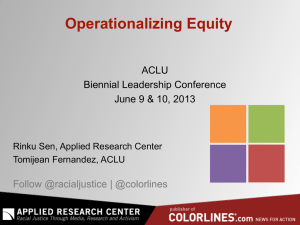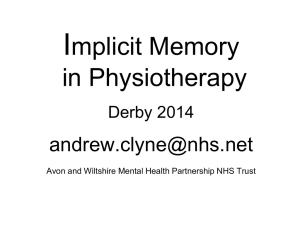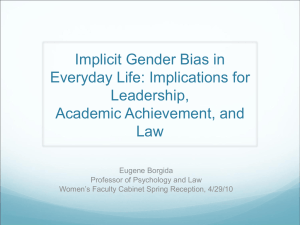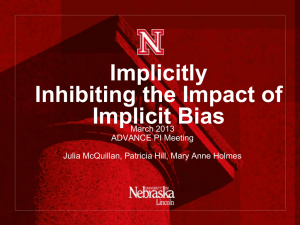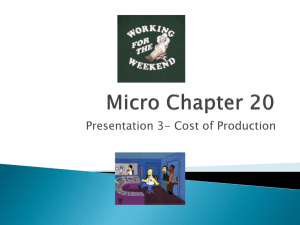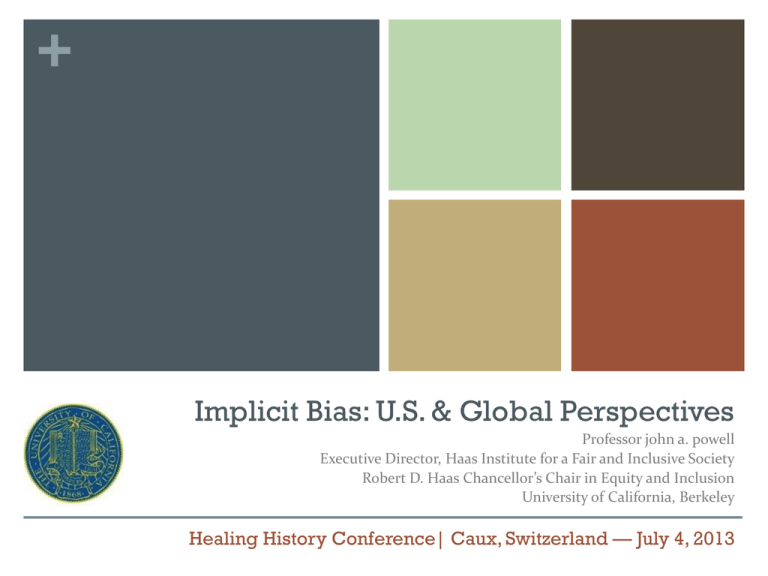
+
Implicit Bias: U.S. & Global Perspectives
Professor john a. powell
Executive Director, Haas Institute for a Fair and Inclusive Society
Robert D. Haas Chancellor’s Chair in Equity and Inclusion
University of California, Berkeley
Healing History Conference| Caux, Switzerland — July 4, 2013
+
The Brain and Othering
Human brain: process 11 million bites
of information in a second
Consciously aware of any 40 of these, at
best
Only 2% of emotional cognition is
available to us consciously
Messages can be framed to speak to
our unconscious
The process of Othering occurs in our
unconscious network: this can lead to
racial, ethnic, or language bias,
Brooks, David. The Social Animal: A Story of How Success Happens. http://www.guardian.co.uk/science/2011/may/08/david-brooks-key-to-success-interview.
The Circle of Human Concern
LGBTQ
persons
Citizens
Felons
Mothers
Children
Elderly
Undocumented
immigrants
Non-public/non-private space
Black and
Latinos
+
Implicit Bias or I/B
The mind naturally makes association: this is intelligence and human
I/B is negative associations that people unknowingly hold, which can be
inconsistent with conscious beliefs
Developed in 1995 by Anthony Greenwald and Mahzarin Banaji
I/B influences our feelings, judgments, and perceptions
Implicit Association Test (IAT) introduced in 1998
Since 1998, over 4.5 million people have taken the IAT online in 34 different
countries
Currently there are 15 IATs
Religion
Presidents
Skin-tone
Race
Asian
Sexuality
Weapons
GenderCareer
ArabMuslim
Native
GenderScience
Weight
Disability
Age
+
Awareness Test
+
Our Brains in Action: Creating
Associations
Please state the color of the text
Blue
Bleu
Red
Rouge
Green
Vert
Black
Noir
Green
Vert
Red
Rouge
Blue
Bleu
Black
Noir
Black
Noir
Blue
Bleu
Green
Vert
Red
Rouge
Green
Vert
Green
Vert
Black
Noir
Blue
Bleu
The Stroop Test
+
Our Brains in Action:
Filling in the Gaps
What shapes do you see?
+
Our Brains in Action:
Filling in the Gaps
Our subconscious fills in the lines for us, to form a shape we
are familiar with
+
Another Way to Think About the
Unconscious Mind at Work: Habits
Habits (or mental pathways) are
behaviors that we engage in without
thinking
Like schemas, individual habits are
created and influenced by our
environment
While habits can come from the structures & systems we occupy,
those structures also have their own habits – the “way things
are done.”
+
Putting It All Together
Automatic categorization, learned
associations, and “filling in the gaps” act
in concert to comprise schemas
Schemas are like the filters or frames
through which our subconscious manages
the 11 million bits of information we
receive every second
They are learned and acquired in childhood and in our adult lives
When we encounter things that don’t fit within the schemas that we
already have, we experience cognitive dissonance
+
Where Do Schemas Come From?
Schemas are social. They exist in our environment, language,
metaphors, etc.
The unconscious is not just an individual or internal phenomenon
The unconscious is social and interacting with the environment
Because we still live in a highly segregated nation, many of us have
limited social contact with people of other races
The media—“local” news, television shows, radio, magazines—mediate many
people’s experiences of other races
+
What Does This Have to Do with
Racial Equity?
Social categories (race, gender,
nationality, religion,
sexual orientation etc.) comprise some of the most
powerful schemas operating at the subconscious level
These schemas give rise to
implicit bias
+
Reacting Before We Even Realize It
The subconscious mind uses three
processes to make sense of the millions of
bits of information that we perceive
1.
Sorting into categories
2.
Creating associations between things
3.
Filling in the gaps when we only receive
partial information
These three processes together add up to
schemas, which are the “frames” through
which our brains help us understand and
navigate the world
+
Race in America:
Implicit & Explicit Bias
“More Americans have attitudes that are both implicit and
explicitly racist than when the same survey was conducted
four years ago…
When measured by an implicit racial attitudes test, the
number of Americans with anti-black sentiments jumped
to 56%, up from 49% during the last presidential
election.”
— Paul Harris, The Huffington Post (2012)
+
Global Perspectives on Gender:
Implicit Bias cont.
Trends in International Mathematics and Science Study
(National Academy of Sciences, 2009)
International study with more than half a million participants in 34
countries: 70% harbor implicit stereotypes associating science with males
more than females
Highest in Mainland China, Romania, and the Netherlands
In countries whose citizens stereotyped most strongly, boys achieved at a
higher level in eighth-grade science and math
Implicit stereotypes may contribute to continuing underachievement
and under-participation among girls and women in science compared
to their male peers
+
Stereotypes and Biases:
Cognitively, We Cannot Avoid Them!
Intelligence is associational and
emotional
We cannot live without schemas
Having biases and stereotypes,
however, do not make us racist; it
makes us human
Conscious
Working for equity and justice
requires engaging at three levels:
Subconscious
1.
The subconscious
2.
The conscious
3.
Structural/environment
Structural
Achieving Transformative Change
Power
(Organization &
Collaboration)
Impact
Implicit Bias
(Communication)
Structural
Arrangements
How do we ensure that our everyday work it is not
hindering transformative change, but rather supporting it?
For more information, visit:
http://www.iupress.indiana.edu/catalog/806639
+
Global Perspectives on Race:
Implicit Bias & Othering
1.
Work-related prejudice against Arab-Muslims in Sweden
(Agerström & Rooth 2008)
2.
Blaming tactics of the Greek financial crisis (Theodossopoulos 2013)
3.
Prejudice against Italy’s Cécile Kyenge (Povoledo 2013)
4.
Greek Panamanians blame austerity measures on mainland Greeks for “lazing
around” and “relying on subsidies”
Increasing multicultural nature of Italian society vs. undercurrent of
racism/xenophobia (immigrants as scapegoats for high unemployment numbers)
Burma’s political debate over ethnicity and religion (Latt 2013)
“Mixed-blood” as default category for Burma’s Muslim population (4-10%)
Demonized as “terrorists and troublemakers” who foment violence
+
Appendix: Resources
Websites
1.
Implicit Association Test: https://implicit.harvard.edu/implicit/demo
2.
Project Implicit: http://www.projectimplicit.net
3.
Equal Justice Society: www.equaljusticesociety.org/law/implicitbias
4.
Implicit Bias & Philosophy International Research Project:
http://www.biasproject.org
+
Appendix: Resources cont.
Bibliography: Implicit Bias Internationally
1.
Baker, D. P., & Jones, D. P. (1993). Creating gender equality: Cross-national gender stratification and mathematical
performance. Sociology of Education, 91-103.
2.
Banaji, M. R. & Heiphetz, L. (2010). Attitudes. In S. T. Fiske, D. T. Gilbert, & G. Lindzey (Eds.), Handbook of Social
Psychology (pp. 348-388). New York: John Wiley & Sons.
3.
Binder, J., Zagefka, H., Brown, R., Funke, F., Kessler, T., Mummendey, A., et al. (2009). Does contact reduce prejudice or does
prejudice reduce contact? A longitudinal test of the contact hypothesis among majority and minority groups in three
European countries. Journal of Personality and Social Psychology, 96, 843-856.
4.
Dunham, Y., Baron, A. S., & Banaji, M. R. (2006). From American city to Japanese village: A cross-cultural investigation of
implicit race attitudes. Child Development, 77, 1268-1281.
5.
Gonzales, P., et al. (2004). Highlights from the Trends in International Mathematics and Science Study (TIMSS) 2003 (US
Dept of Ed., Washington, DC) (NCES no. 2005-005).
6.
Guiso, L., Monte, F., Sapienza, P., & Zingales, L. (2008). Culture, gender and math. Science 320: 1164-1165.
7.
Lummis, M., & Stevenson, H. W. (1990). Gender differences in beliefs and achievement: A cross-cultural study.
Developmental Psychology, 26(2), 254.
8.
McGrane, J. A. and White, F. A. (2007), Differences in Anglo and Asian Australians' explicit and implicit prejudice and the
attenuation of their implicit in-group bias. Asian Journal of Social Psychology, 10: 204–210. doi: 10.1111/j.1467839X.2007.00228.x
9.
Nosek, B. A. & Banaji, M. R. (2002). [Polish Language] (At least) two factors moderate the relationship between implicit and
explicit attitudes. In R.K. Ohme & M. Jarymowicz (Eds.), Natura Automatyzmow (pp. 49-56), Warszawa: WIP PAN & SWPS.
10.
Nosek, B. A., Smyth, F. L., Sriram, N., Lindner, N. M., Devos, T., Ayala, A., Bar-Anan, Y., Bergh, R., Cai, H., Gonsalkorale, K.,
Kesebir, S., Maliszewski, N., Neto, F., Olli, E., Park, J., Schnabel, K., Shiomura, K., Tulbure, B., Wiers, R. W., Somogyi, M.,
Akrami, N., Ekehammar, B., Vianello, M., Banaji, M. R., & Greenwald, A. G. (2009). National differences in gender-science
stereotypes predict national sex differences in science and math achievement. Proceedings of the National Academy of
Sciences, 106, 10593-10597.

